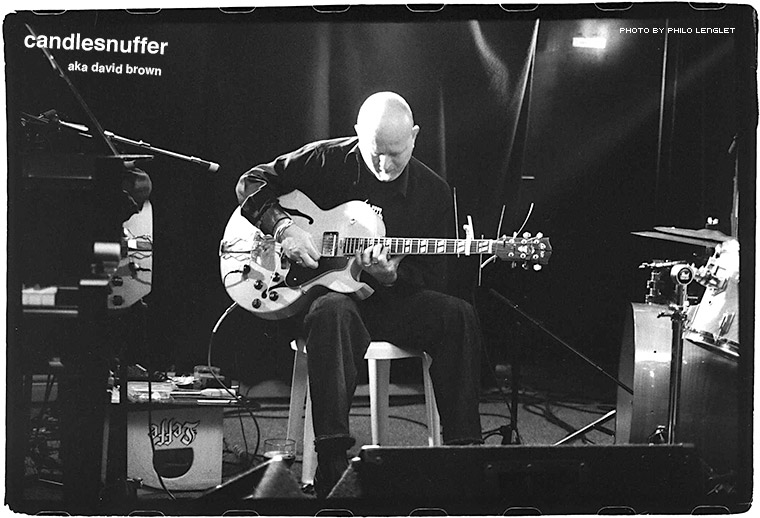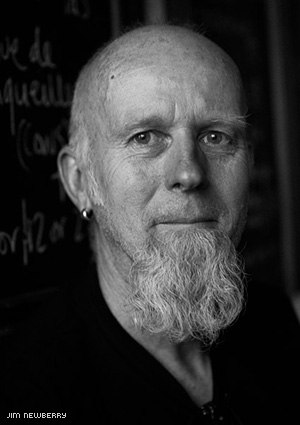
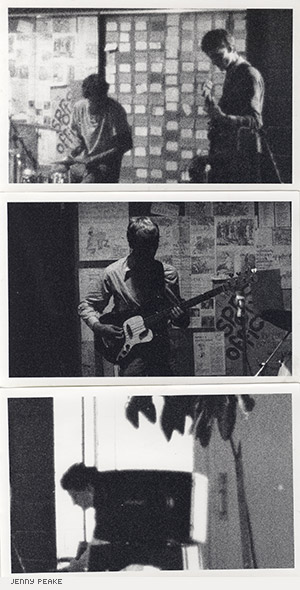
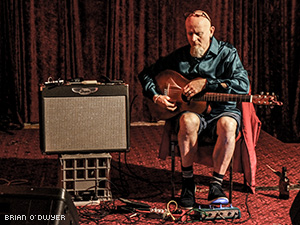

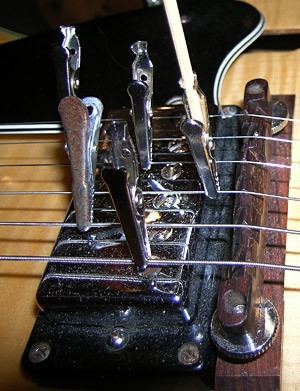
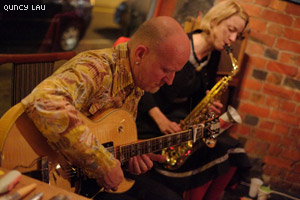
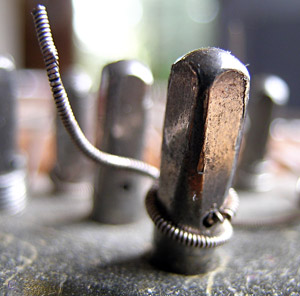
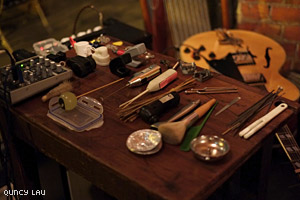
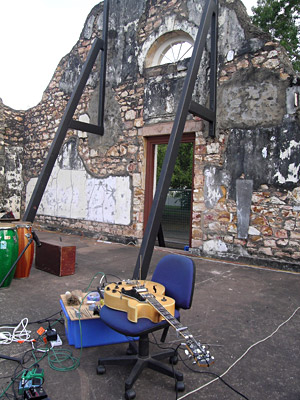
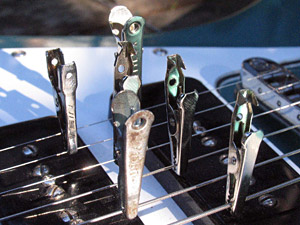


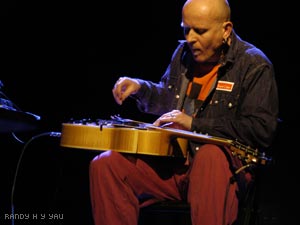
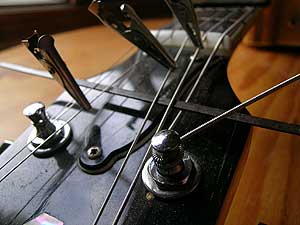
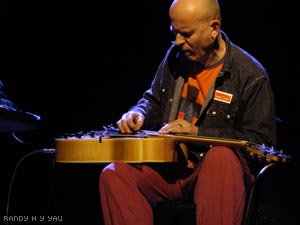
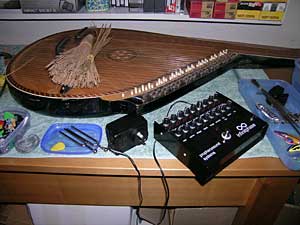
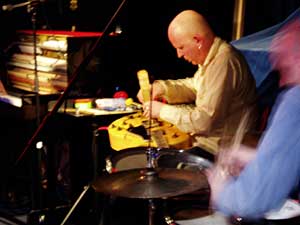
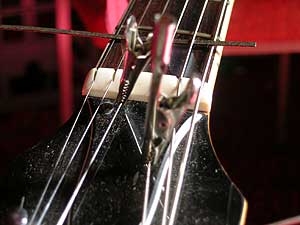
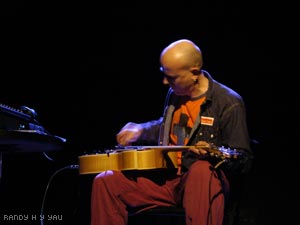
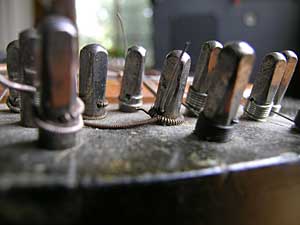
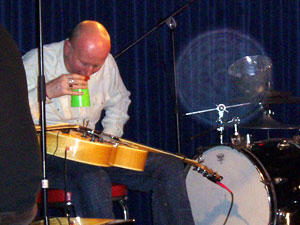
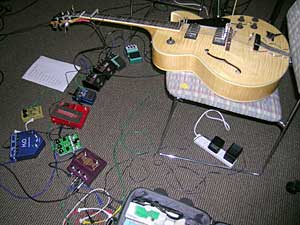
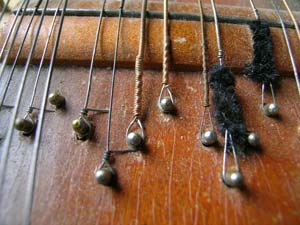
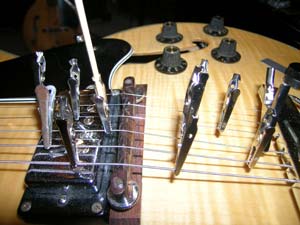
Culture of Un
I find I'm increasingly listening to more music live, compared to the medium of recordings - except of course when these are involuntary i.e. muzak. That said, while silence in our environment is increasingly desirable and unattainable, it's my perception that the quality of muzak in some ways has risen - they may not realise it, but many people now know the Blue Note classics of the 60s from hearing them in Starbucks and similar outlets. Live in 2013, I finally caught the celebrated NOW NOW Festival in Sydney, where one highlight was the deliciously low-key Culture Of Un - the Necks' Chris Abrahams on piano, and Dave Brown (aka Candlesnuffer) on prepared guitar (the name has nothing to do with the United Nations). Songs of Restraint and Release by Moon Hyun and Lee Joo-Eun were featured in Durham's excellent annual festival of Korean and East Asian Music, while at Bergamo Jazz, I was impressed by the searching artistry of Mary Halvorson's Quintet, with their quirky, mostly groove-based directions. Jon Rose's polemic Music of Place raised piquant issues, as did the Tadd Dameron biography by Paul Combs - good to see there are still people prepared to devote years of work and research to such neglected figures. Albums of the year: the highly creative Far Flung by Australian jazz pianist and composer Alister Spence (Rufus), and AUM's wonderful box set of William Parker's Wood Flute Songs. Pitiful release of the year: Walking Shadows by Joshua Redman showed that "jazz with strings" is still alive if not exactly kicking.
Andy Hamilton, The Wire, January 2014
Culture of Un, Hakea
Culture Of Un is Chris Abrahams of the Necks on piano, and Dave Brown (aka Candlesnuffer) on prepared guitar. The name implies nothingness, not the United Nations. Their demeanour was quiet and low-key, like the technology - piano filigree contrasting with quiet eruptions from prepared acoustic guitar, mostly laid flat. Livelier preparations included electronic gizmos rather in the spirit of Lee Patterson - though Dave Brown has always followed his own path with quiet resolve. In contrast with their CD Moonish, reviewed in The Wire 341, the playing was spare, though the guitarist commented that the sound-level had been set lower than intended. His prepared guitar figured in a more in-your-face performance later in the festival, with Rosalind Hall often raucous on equally prepared sax.
Andy Hamilton, The Wire, April 2013
candlesnuffer/Lukas Simonis
Dave Brown and Lukas Simonis' prepared guitar improvisation set, on the other hand, displayed an almost furious attention to soundscape construction, at least in the short-term interactions of the two guitarists with their armoury of kitchen utensils.
Mathew Lorenzon, excerpt from Reciprocity between sounds - Liquid Architecture, Melbourne, Realtime, Aug/Sept 2011
candlesnuffer/Kim Salmon duo
Kim Salmon and David Brown reprised their appearance at the Overground component of the Melbourne Jazz Festival for this Make It Up Club set (they've since performed at Stutter and as part of Salmon's month-long residency over November at The Old Bar). The term 'punk legend' gets bandied around with indecent ubiquity, but it's hard to avoid it when discussing Kim Salmon in the context of the Australian music scene of the 1980s/90s. His groups The Scientists and The Surrealists anticipated (arguably bettered) Grunge and he was part of the original line-up of the Beasts of Bourbon with Tex Perkins that cut the epochal album The Axeman's Jazz in 1984. While The Saints' Chris Bailey or Ed Keupper may have enjoyed greater mainstream visibility, it is Salmon who most deserves to be considered Australia's equivalent to John Lydon. He certainly shares the PiL leader's experimental teenage passions (Can/Bitches Brew/Beefheart/Sun Ra) and you can hear elements of those influences in such exemplary locked groove psych as 'Human Jukebox'. The Scientists' 'Set It on Fire' and Beasts of Bourbon's 'Save Me a Place in the Graveyard' are mesmeric engines of simmering aggression built on the juxtaposition of fractal riffage and cruising freakbeat. The title track of the Beasts' 1990 release Black Milk has all the pagan blues momentum of a late 60s Dr John voodoo rock session. Salmon continued the experimental side of his career with this set which he began with slide guitar and wah-wah, alternating tonal clusters with sonic roots in the blues amidst flavours of Dieter Moebius in dada guitar mode or early Kraftwerk 'Ananas Symphonie'-style Hawaiian exotica weirdness.
As anyone remotely familiar with the Melbourne experimental scene will know, there are two David Browns - one, the astringent electric master of sustain and distortion and missing link between Robert Fripp at his gnarliest and the unfettered explorations of Derek Bailey; the one who, in a duet for Stutter with Cat Hope last year, submerged the interior of Horse Bazaar in a double bass lavastream of sonic viscosity, air waves roiling with microtones and overtones in subatomic conflict/resolution. And there's the (relatively) quieter, deep listening one of the prepared guitar who performs on this occasion. His instrument of choice is a hollowbody, festooned with various metal appendages, some struck and allowed to resonate, producing a range of buzzing, rattling timbres. Brown's prepared guitar is a beguiling sound world unto itself, his playing an exercise in disciplined command over a deceptively restricted sound palette as demonstrated on the releases Wakool and Mimosa. For this set, his textural sensitivity blends in and leavens Salmon's methodology which, in this era of digital sampling and Ableton Live processing, could be described as art brut concrete.
Salmon has two dictaphones hanging around his neck and he uses them as primitive time machines in the experimental vein of William Burroughs, Ian Sommerville and Brion Gysin, generating and overlapping temporal striations to which Brown adds real time counterpoint. The two-chord Hawaiian blues theme is played back into the microphone, a trebly, distorted simulacra used as accompaniment for more low-end bluesy lines. Various feedback sonorities, dirty and fractured, begin to intersect. Another dictaphone in ultra slow playback mode is added to a sustained whine from the hollowbody, Brown manipulating it by placing a finger on a resonating string.
Strategies utilising electromagnetic interference gradually dominate the performance: Salmon unplugs his guitar and uses his thumb to create rhythmic manipulations of the cord signal; Brown drops chains onto the guitar's face and moves metal held close to the body, generating dive bombing variations in tone that suggest hydroacoustic Doppler effect and conjure sonar pulses sucked into chasms. Brown then sets to rubbing a metal agitator over the guitar body, a whirring milk frother that strikes the strings and resonators at oblique angles, coaxing shifting metallic timbres. Towards the end of the set he summons distressed whale song by gently stroking the guitar with rubber mallets while Salmon's slowed down dictaphone recordings of deconstructed blues descend into a soundscape pitched between ethereality and electric mud. This is process music at its most enjoyably unhinged, where final destination is irrelevant and the accumulation of detail in drifting simultaneity all.
Jonathon Kromka, Aeternal Flux, 2010
Pateras/Baxter/Brown
... The best act of the night was Anthony Pateras / Sean Baxter / David Brown, a trio of Aussies that improvised on prepared piano and guitar and drums. The music was
somehow raucous and sophisticated all at once, and the dynamic tension among the three
was fascinating to watch. The oldest member of the group sat in the middle and tweaked the prepared strings of his polished guitar with the precision of an acupuncturist. He remained stoic throughout the set. The men to his right and left, however, let fly. For a while I thought the pianist had
even taken the strings completely out of his instrument. In fact, he had loaded that baby
with handfuls of common bolts and screws which somehow yielded tones remarkably
similar to those from an African mbira. I loved his playing style: he often looked more like a furious stenographer than a pianist, his fingers typing madly over each other at the high
end of the keyboard. He used the butt of his palm to mash rows of keys at once. The
playing, however, was passionate without being wayward. It was the perfect counterpoint
to the broad poise of the guitar and the childlike violence taking place on the drumkit a few
feet away. The drummer used a large set of wind chimes as "drumsticks" and simply pulverized his kit
with them. He shoved the chimes into the drums, as if they were long metal pills to be
swallowed by the drums' flat mouths. His foot was always on the kick pedal, sending
agitated rolls of bass tone through the cacophony spilling out above them. At one point his
drumsticks were actual sticks (like from trees), which he broke and dropped onto the
drums from two feet above.
In the last piece, he used tin flatware to attack his drums. After several minutes of battering breadpans and platter covers, the piece reached its dramatic peak as he cracked a plastic plate with agonizing slowness. He and the pianist often looked at each other as they
played: the pianist's head bobbed; the drummer's eyes widened with what looked like the
fierce hope that he could keep assaulting his kit all night...
Split Foster, Tiny Mix Tapes, 2006
Candlesnuffer
... Triggered by a guitar with effects pedals, the track bristled with the horror of a sci-fi film score. With the Botanic Garden bats looming overhead, this was a Hitchcock movie in the making.
Xenia Hanusiak, Herald Sun, 2001
The second event was an improvisation for electric guitar and 10 footpedals accompanied by a quadraphonic soundscape recorded on two CDs by Melbourne guitarist/ composer/ improviser Dave Brown. This was a lovely performance. The soundscape on the CDs consisted of many different short sharp bursts of scritchy sounds, intricate textures, and sounds which sounded like they were recorded with high levels of intentional distortion and then rerecorded softly. Brown started off with conventional electric guitar sounds, but when he began working with his 10 pedals - which essentially amounted to an analogue synthesiser he was processing his guitar through - those sounds got crunchy, too. I was seated where I could see his performing movements very clearly. There was an interesting contradiction between the high energy of his performance and the interestingly light electronically distorted sounds he was producing. Brown is in love with distortion. But in this piece, his use of SOFT distortion, created by heavy gain limiting, made me hear the distortion as a discrete texture, as an object rather than as a magnified distortion of an "other" sound. His lovely sense of phrasing made this one of the most beautiful of his pieces I've ever heard.
Warren Burt, Computer Music Journal USA, 1999
Bucketrider
...The more furiously the musicians assaulted their instruments, the more ardent the applause became. It was hard to tell whether those who made up this attentive and willing crowd were "jazz literate"...
Jessica Nicholas, The Age, Melbourne, 2001
... something has to give. But that's just the point. It's an exercise in cultural clash as well as magnificent crime. Everyone loves a car crash...
... By categorising themselves as a jazz band and then playing a rock show, bucketrider poke fun at that homogenous crew of humourless chops-hounds the (moribund and po faced) jazz academy. Their refusal to take themselves entirely seriously is, in itself, a serious challenge to the jazz orthodoxy. It'll probably be entirely ignored - but that doesn't matter, because Bucketrider are a great rock band.
Ben Butler, Beat Magazine, 1997
...bucketrider attacked music and art with scissors and technology and gusto and managed to jump through a multiplicity of hoops. The horns clashed and colluded, the drummer ran through the audience to other kits, the mixer heard the crackle in one of the amplifiers and turned it up. It was sublime and brutal...
Iain Downie, Beat Magazine, 1998
Jazz-punk-noise-improv-terrorists Bucketrider have a love (or is that fetish?) for musical adventure and they expect the audience to join in. The launch of their latest release
"Le Baphomet" was clearly planned to be an event. The plan was risky, given the location and the audience, but it was a clear success. Sean Baxter and Erick Mitsak kicked the evening off with their version of Samuel Beckett's play "Words and Music". What was it "about"? Well, it revolved around human nature, sloth, fascination, love, old socks, the competition between words and noises, and the difficulty in moving by walking frame or inside a suitcase.
Next up, Tim O'Dwyer and Greg Kingston used their whole bodies to set up music of tension and release with saxophone and treated guitar. Snatches of jazz melody or metallic frenzy constantly threatened to burst through a taut skin of noise. Greg also made me wonder whether that was him breaking through the skin of performance, as he slapped himself, shot himself in the mouth with a cap-gun, or quipped "just fuckin' keep talkin' that's fine" to the crowd. Jaw-dropping stuff.
We were then given the Ballarat Bum Puppets' take on video piracy and sci-fi remakes. I won't ruin the stunning impact of seeing them yourself, but let's just say they take literally the phrase "talking out of your arse". Before playing "Le Baphomet" from start to finish, Bucketrider introduced the audience to their aesthetic, simultaneously butchering and breathing new life into "Say My Name" and "Careless Whispers". They're hard to pin down - just when you think they're smooth and rehearsed they assault your ears, collapsing into noise. At times impassioned, other times wry and laconic, often both, they could be trying to build a bridge between virtuosity and pub ugliness. Tonight, the bridge is built which inspires some of the audience to dance on it, in their own unconventional way. The encore is introduced by a snappy rant against the sycophancy surrounding recently departed rock icons, but is quickly surpassed by an abrasively hypnotic jam-like piece. Hard to tell if Bucketrider are picking up converts, but if the crowd size and response is anything to go by, it seems Melbourne is fond of musical adventure. Now, if we can only manage to prize them away from their televisions and get them into the Make It Up Club on Tuesdays. That would really be something.
Andy Jackson, Beat Magazine, 2001
... bucketrider came on, fired up for an explosive CD launch performance, and supernovered the senses with a free-form prime mover, inspired by the meditations of free-jazz father Coltrane himself. When a band improvises like this, it's like bathing in a smooth sea of formlessness...
...their combo of methamphetamine Deleuzean drums, rhino chasing electric bass, and triple Tibetan Pompeii horns, creating a primeval sound that threatened to shatter the ivory towers of almost all that had previously dared to call itself music culture.
...The band finds a riff. Instead of replicating it exactly eight times, they immediately start varying micro-elements of it; though slightly, subtly, almost imperceptibly. One of the horns will shift one note a semi-tone higher, whilst another horn keeps it the same, whilst the other goes one lower; whilst the bass shifts another element higher two pulses later; whilst the drummer now puts a bass-drum hit where he previously had the snare; whilst the whole band cuts the next cycle short by one pulse. But somehow, it's still the same riff, depends on how you locate yourself as perceiver.
Tim Themi, Inpress Magazine, 2001
... a band of fancy dressed people entered the stage. Seven masters of wind lined the front of the stage dressed in penguin plastic costumes with sequined necklines and faces made-up beautifully. One even wore a stars and moon headset...
... the 12-piece had a lot of fodder for their gig. And they put it together well. Two sets of fun, ripe beats with a wonderful moulding of instruments and the occasional hypnotically infectious lyric - I'm still singing "Why go to the moon, go to the intergalactic". The music bounced from the stage and moved every audience member.
I am sure Space is the Place: A Tribute to Sun Ra will be the highlight of the festival.
Celia Kennedy, Melbourne Times, 2000
Terminal Hz
The set was opened with a track called Tequila and if it was indeed a cover of the famed party song then it was the most truthful sounding I've ever heard. The song crawled around the floor, stumbled over the coffee tables, tried to get a conga line started, threw up, felt better, and had another swig. There was another song where KK Null's guitar approximated the sound of a Concord taking off. This was just incredibly good stuff.
Englebert Schmidl, Inpress 1997
Dumb and the Ugly
... the 'Ugly boys specialize in absolutely huge trio thug-rock pummel of the Swans variety that totally beats its repetitive riffage into the base of your skull. Primarily an instrumental band, 'Ugly have a knack of creating a huge riff and beating it into the ground until it takes on a life of its own.
Dave Lang, Year Zero, 1993
... two recent shows by Dumb and the Ugly had me silent with awe at the forces interacting on stage. It was like an ultimatum; Armageddon imminent, Ragnarok, the tremendous feeling of finality and doom engendered was similar to the electricity and darkness just prior to a massive storm...
Fast sections are ripped out by Dave Brown's nimble fingers while Murphy sits back and beats out a great flat-out rock beat, a matrix upon which Sheridan pours forth wonderful guitar - slashing ringing chords.
Jim Glaspole, Zeeeeen
